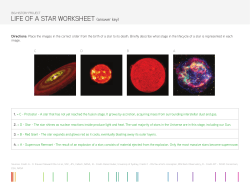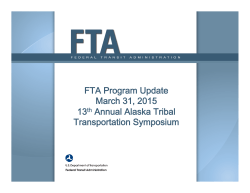
Looking for atmospheric signatures of the exop
Looking for atmospheric signatures of the exoplanet Qatar-1b Carolina von Essen1 , Sergio A. Cellone2 , Simon Albrecht1 & Stefan Dreizler3 1: Stellar Astrophysics Centre, Århus, Dinamarca 2: IALP (CONICET-UNLP) and FCAG (UNLP) 3 Institut für Astrophysik, Georg-August-Universität Göttingen, Alemania 15 años de ciencia con Gemini en Argentina 1 / 21 Planetario de La Plata, 1-5/jun/2015 Motivation The formation and composition of a planetary atmosphere depends mainly on: • the evolutionary history of the planet • its distance to the host star • the position in the proto-planetary disk at which the planet was formed 2 / 21 Motivation The formation and composition of a planetary atmosphere depends mainly on: • the evolutionary history of the planet • its distance to the host star • the position in the proto-planetary disk at which the planet was formed Studies of exoplanet atmospheres: → 2 / 21 probe exoplanet formation and evolution Transit spectroscopy Basic layout Geometry of transit spectroscopy: the photons from the star are filtered through the atmosphere of the planet (Tinetti et al. 2013, A&AR, 21, 63) 3 / 21 Transit spectroscopy Some previous results Detected elements and molecules: Na in HD 209458b (Charbonneau et al. 2002, ApJ, 568, 377; Sing et al. 2008a, ApJ, 686, 658; 2008b, ApJ, 686, 667, with HST; Arribas et al. 2006, PASP, 118, 21, with WHT); in HD 189733b (Redfield et al. 2008, ApJ, 673, L87) K in X0-2b (Sing et al. 2011, A&A, 527, A73) H2 O in HD 189733b (Deming et al. 2013, ApJ, 774, 95) CH4 in HD 189733b (Swain et al. 2008, Nature 452, 329) 4 / 21 Transit spectroscopy Methodology Most favourable conditions • relatively bright host star • large transit signal • low planetary surface gravity 5 / 21 Transit spectroscopy Methodology Most favourable conditions • relatively bright host star • large transit signal • low planetary surface gravity Also, in the particular case of low-resolution transmission spectroscopy • adequate reference stars within the field of view 5 / 21 The target: Qatar-1b Physical and geometrical characteristics host star ST mass RS distance V K3V 0.85 M 0.82 R ∼ 200 pc 12.8 mag planet RP 1.16RJ a ' 0.023 AU T ∼ 1.42 d i 83.47◦ surf. gravity 20 m/s2 6 / 21 The target: Qatar-1b Physical and geometrical characteristics host star ST mass RS distance V K3V 0.85 M 0.82 R ∼ 200 pc 12.8 mag planet RP 1.16RJ a ' 0.023 AU T ∼ 1.42 d i 83.47◦ surf. gravity 20 m/s2 6 / 21 ←− hot Jupiter (Tsup & 1400 K) The target: Qatar-1b Observational conditions 100 QATAR−1 HD189733 HD209458 HATP−32 WASP−12 WASP−17 WASP−19 XO−2 Surface gravity (m/s2) 80 60 40 20 × × × 0 0.01 7 / 21 0.015 0.02 0.025 Transit depth ([RP/Rs]2) × × 0.03 Observational setup program: instrument wavelength coverage: CCD read mode: CCD binning: slitlet size: 8 / 21 GN-2014B-Q-47 (PI: Cellone) GMOS-N (MOS mode) + B600 grating ∼ 500 →∼ 750 nm (centered at the Na feature at 589 nm) fast 4×2 ∼ 30 (long) × 15 (width) arcsec Observational strategy Preimage and mask ←− Qatar 1 9 / 21 Observational strategy Spectra ←− Qatar 1 10 / 21 Observational strategy • 75 frames × 150 s integration each • taken on September 2, 2014, between 08:10:32.7 UT and 12:03:50.0 UT: ◦ 20 before transit ◦ 35 during transit ◦ 20 after transit • 1.43 ≤ airmass ≤ 2.06 • six field stars of similar brightness as Qatar-1A as reference → 11 / 21 differential spectro-photometry (Bean et al. 2010, Nature, 468, 669) Data reduction Gemini-IRAF standard tasks: • overscan subtraction • bias subtraction • flat-fielding • wavelength calibration (Cu-Ar) • extraction of spectra: ◦ apertures: 1, 2, 3, 5, 8, 10, 15 ×hFWHMi (hFWHMi ' 2 binned pix ≡ 0.6 arcsec) 12 / 21 White light curve analysis Selection of best aperture and reference star White light curves were constructed (for each aperture) by: • integrating fluxes between 550 and 750 nm • dividing Qatar-1 / reference star (different combinations) 13 / 21 White light curve analysis Selection of best aperture and reference star White light curves were constructed (for each aperture) by: • integrating fluxes between 550 and 750 nm • dividing Qatar-1 / reference star (different combinations) Looked for minimum scatter in: • off-transit data points • on-transit data points after least-squares transit fit 13 / 21 White light-curve analysis Results: best aperture: r = 2 × hFWHMi = 1.2 arcsec best reference stars: RS2 (shown in blue) and RS1 (green) 14 / 21 White light-curve analysis Transit fitting • transit model (Mandel & Agol 2002, ApJ, 580, L171): a/RS : normalized sma i: orbital inclination RP /RS : planet radius / star radius ratio T0 mid-transit time • “detrending” function: ◦ airmass (cubic) ◦ seeing (linear) 15 / 21 White light-curve analysis Transit fitting detrending function 16 / 21 White light curve analysis Results 1 Normalized flux 0.995 0.99 0.985 0.98 Residuals 0.975 1.002 1 0.998 -0.04 17 / 21 -0.02 0 0.02 Orbital phase 0.04 -0.04 -0.02 0 0.02 Orbital phase 0.04 White light-curve analysis Results Parameter a/RS i [deg] RP /RS T0 − 2456092 [JD] 18 / 21 This work RS1 6.424 ± 0.077 84.51 ± 0.18 0.1467 ± 0.0008 0.93881 ± 0.00006 This work RS2 6.594 ± 0.098 84.86 ± 0.21 0.1433 ± 0.0008 0.93892 ± 0.00006 White light-curve analysis Results Parameter a/RS i [deg] RP /RS P [days] 19 / 21 von Essen et al. (2013) 6.42 ± 0.10 84.52 ± 0.24 0.1435 ± 0.0008 1.4200246 ± 0.0000004 Maciejewski et al. (2015) 6.319+0.070 −0.068 84.26+0.17 −0.16 0.14591+0.00076 −0.00078 1.42002406 ± 0.00000021 Results (so far . . . ) White light-curves with excellent S/N have been obtained for a transit of Qatar-1b To be done . . . • construction of transit light-curves in several (up to 29) different spectral ranges (each one ∼ 15 → 20 nm wide) • look for changes in RP /RS between different wavelength ranges, consistent with an Na absorption feature in the planet’s atmosphere 20 / 21 ¡Muchas gracias! 21 / 21
© Copyright 2025









